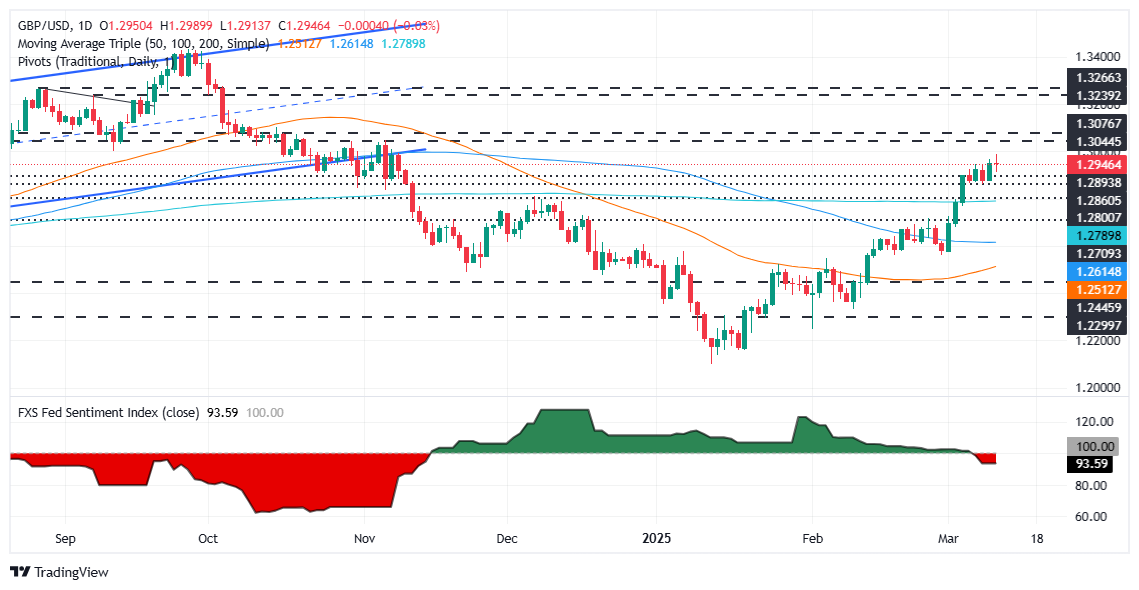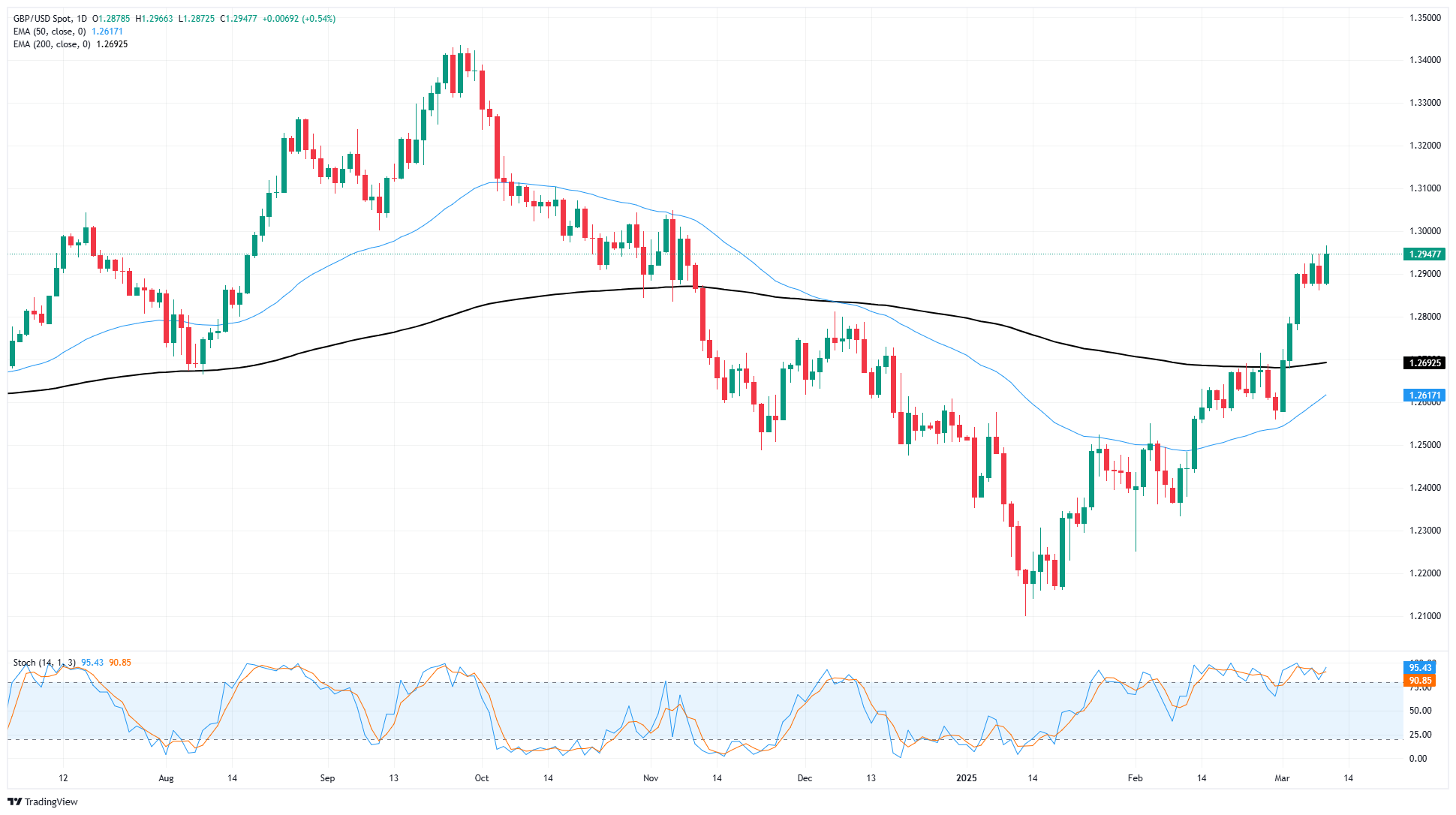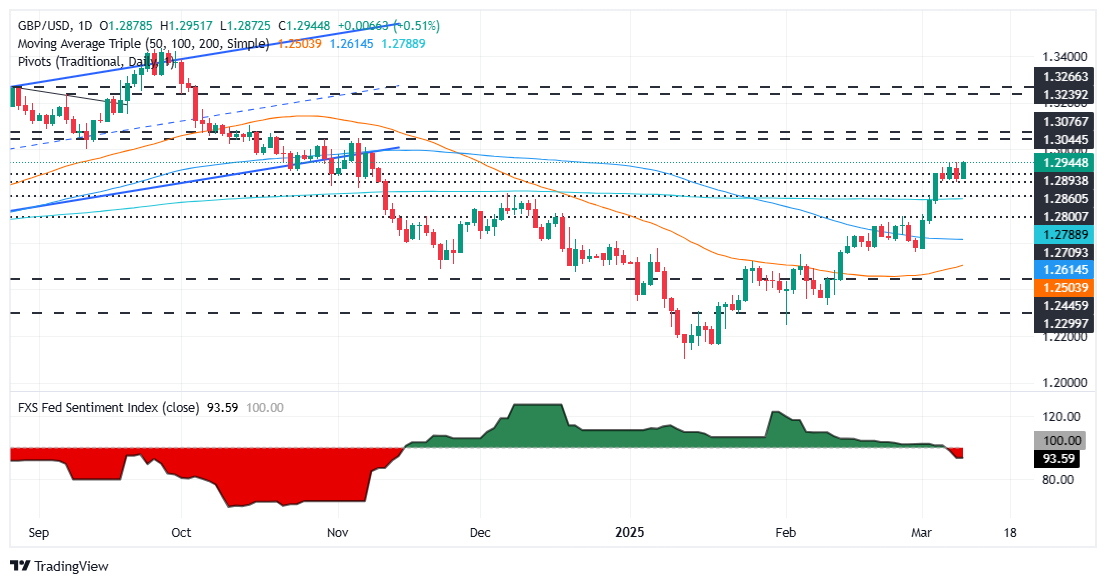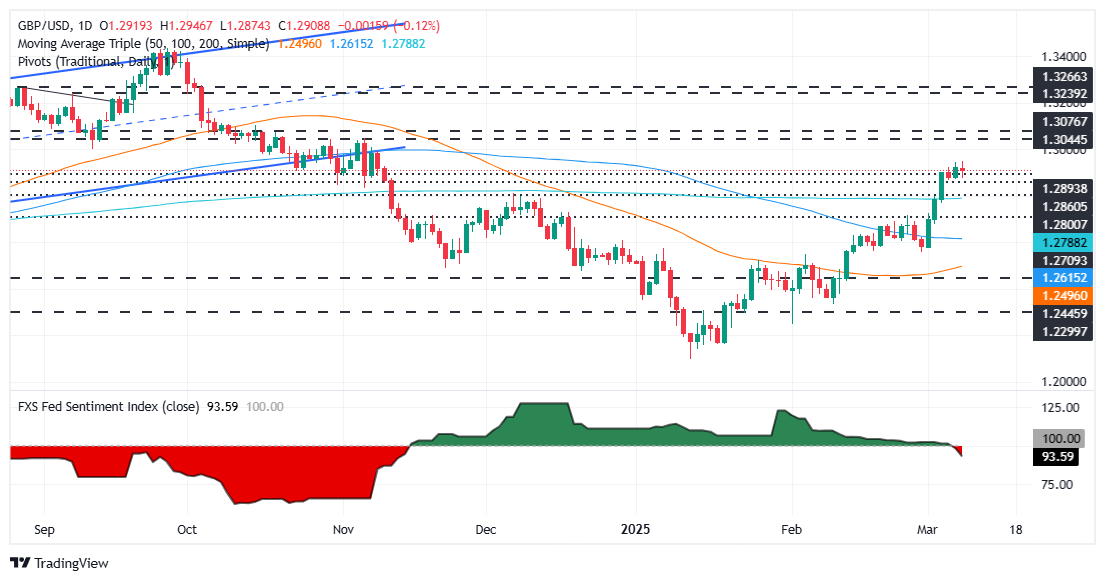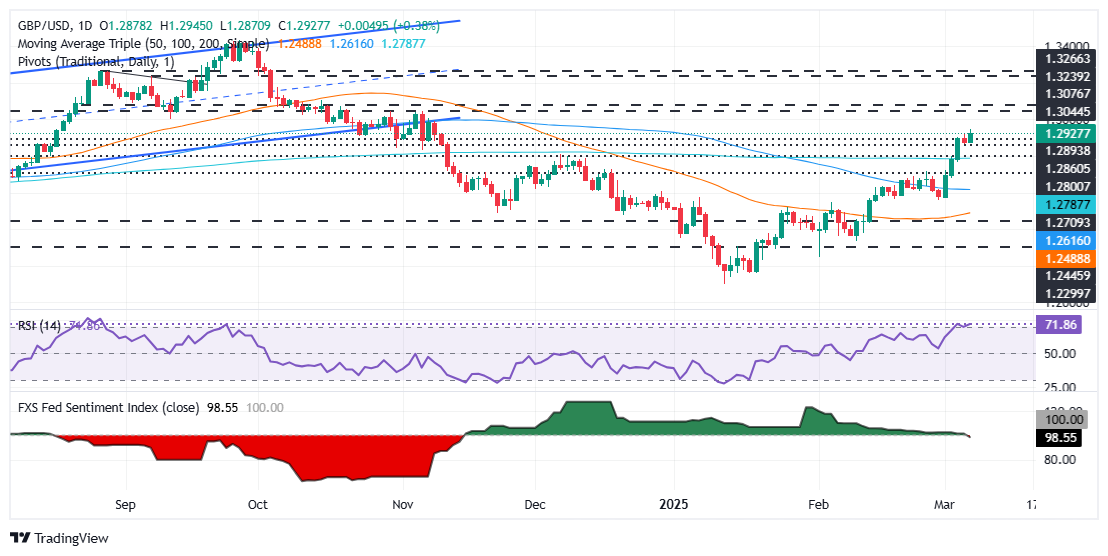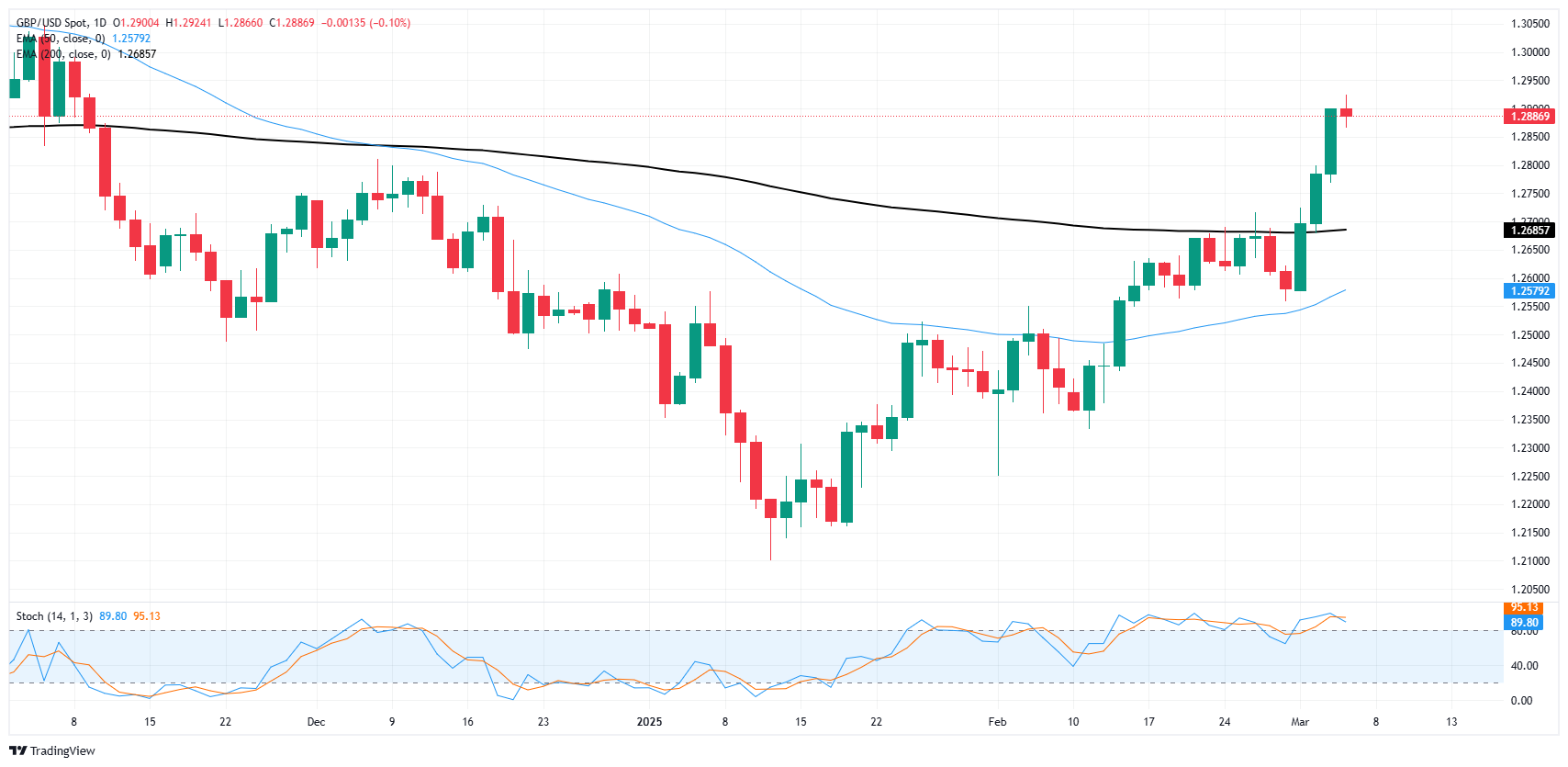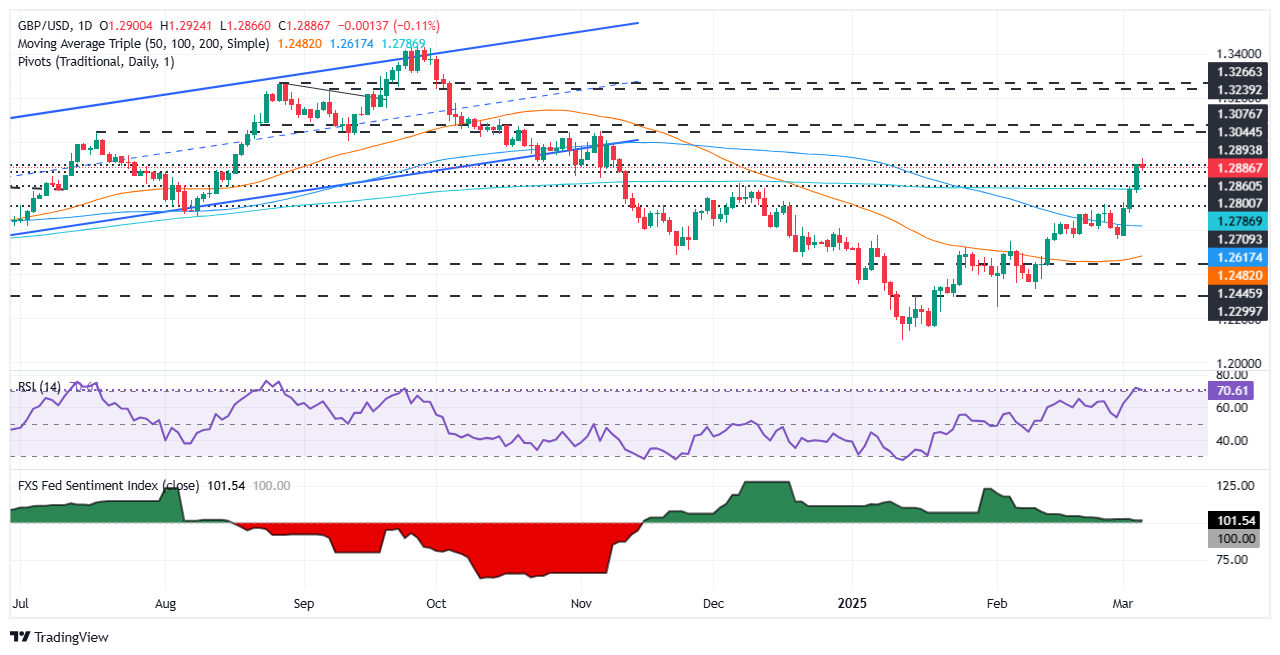- Analytics
- News and Tools
- Quotes
- Chart and quotes for GBPUSD
CFD Trading Rate Great Britain Pound vs US Dollar (GBPUSD)
| Date | Rate | Change | |
|---|---|---|---|
| 03.04.2025 | 1.30887 | -0.08% | |
| 02.04.2025 | 1.30986 | 0.78% | |
| 01.04.2025 | 1.29973 | 0.59% | |
| 31.03.2025 | 1.29215 | 0.05% | |
| 30.03.2025 | 1.29146 | -0.22% | |
| 27.03.2025 | 1.29427 | -0.06% | |
| 26.03.2025 | 1.29502 | 0.57% | |
| 25.03.2025 | 1.28769 | -0.51% | |
| 24.03.2025 | 1.29435 | 0.18% | |
| 23.03.2025 | 1.29203 | 0.05% |
Related news
-
13.03.2025 15:31GBP/USD holds steady near 1.2950 as traders brace for UK GDP data
- GBP/USD remains near 1.2950, cautiously, after US PPI data came slightly below expectations at 3.2% YoY.
- US jobless claims fell to 220K, highlighting labor market resilience despite mixed inflation outlook from recent tariffs.
- Traders anticipate UK GDP report Friday; expected slowdown to 0.1% MoM.
The Pound Sterling stayed firm at nearly 1.2950 against the Greenback on Thursday following the release of economic data from the United States (US). Inflation and jobs figures came in mixed but signaled that the economy remains solid. The GBP/USD trades at 1.2948, down 0.07%.
Mixed US economic signals keep Sterling rangebound; upcoming UK growth report eyed as next catalyst
Data from the US showed that prices paid by producers were mainly aligned with estimates. The US Bureau of Labor Statistics (BLS) revealed that the Producer Price Index (PPI) in February came softer than the 3.3% expected at 3.2% YoY, down from the prior month’s 3.7%. Excluding volatile items, the so-called Core PPI increased by 3.4% YoY, beneath estimates of 3.5% and down from 3.6%.
Even though the latest US inflation reports were cooler than foreseen, tariffs imposed on imports to the US can spark a reacceleration of inflation, with economists estimating that prices will begin to rise in the months ahead.
Other data showed that Initial Jobless Claims for the week ending March 8 dipped from 222K to 220K, below forecasts of 225K.
Across the pond, traders are eyeing the release of Gross Domestic Product (GDP) figures on Friday. The 3-month rollover is estimated at 0.3%, up from 0.1% in the previous report. GDP in January is expected to dip from 0.4% to 0.1% MoM.
In the US, investors would digest the University of Michigan (UoM) Consumer Sentiment report for March.
GBP/USD Price Forecast: Technical outlook
The GBP/USD continues to trade sideways, unable to clear below/above the 1.2900 – 1.2950 range for the last two days. The Relative Strength Index (RSI) is near overbought territory yet almost flat. Therefore, traders are awaiting a fresh catalyst to drive the pair outside of the previously mentioned range.
A bullish continuation would happen once GBP/USD clears 1.2950, opening the door to challenge 1.3000. On the other hand, a drop beneath 1.2900 would clear the path to test the current week’s low of 1.2860, ahead of the 200-day Simple Moving Average (SMA) at 1.2791.

British Pound PRICE Today
The table below shows the percentage change of British Pound (GBP) against listed major currencies today. British Pound was the strongest against the Australian Dollar.
USD EUR GBP JPY CAD AUD NZD CHF USD 0.28% 0.16% -0.28% 0.20% 0.48% 0.37% 0.28% EUR -0.28% -0.12% -0.58% -0.10% 0.20% 0.11% -0.00% GBP -0.16% 0.12% -0.46% 0.03% 0.32% 0.23% 0.15% JPY 0.28% 0.58% 0.46% 0.46% 0.76% 0.66% 0.61% CAD -0.20% 0.10% -0.03% -0.46% 0.30% 0.19% 0.11% AUD -0.48% -0.20% -0.32% -0.76% -0.30% -0.08% -0.20% NZD -0.37% -0.11% -0.23% -0.66% -0.19% 0.08% -0.05% CHF -0.28% 0.00% -0.15% -0.61% -0.11% 0.20% 0.05% The heat map shows percentage changes of major currencies against each other. The base currency is picked from the left column, while the quote currency is picked from the top row. For example, if you pick the British Pound from the left column and move along the horizontal line to the US Dollar, the percentage change displayed in the box will represent GBP (base)/USD (quote).
-
13.03.2025 08:53GBP/USD to test 1.3000 in the near term – UOB Group
-
13.03.2025 03:48GBP/USD maintains position above 1.2950 near four-month highs
-
12.03.2025 23:35GBP/USD holds steady near fresh highs as markets take a breather
-
12.03.2025 15:20GBP/USD slides despite cooling US inflation, eyes on US PPI
-
12.03.2025 09:35GBP/USD may have just enough momentum to test 1.2975 – UOB Group
-
12.03.2025 03:02GBP/USD trades with negative bias below mid-1.2900s, downside seems limited ahead of US CPI
-
11.03.2025 23:04GBP/USD shrugs off tariff fears as Pound continues to recover ground
-
11.03.2025 15:32GBP/USD climbs above 1.2920 as trade war fears weaken USD
-
11.03.2025 08:52GBP/USD: Upward momentum is slowing – UOB Group
-
11.03.2025 02:43GBP/USD maintains position near 1.2900 as concerns over US economic growth persist
-
10.03.2025 15:22GBP/USD holds above 1.2900 as traders brace of US CPI data
-
10.03.2025 00:54GBP/USD stands firm near multi-month peak, just below mid-1.2900s on weaker USD
-
10.03.2025 00:54GBP/USD stands firm near multi-month peak, just below mid-1.2900s on weaker USD
-
07.03.2025 15:22GBP/USD climbs above 1.2900 following US NFP data
-
07.03.2025 09:47GBP/USD: Outlook for GBP remains positive – UOB Group
-
07.03.2025 03:46GBP/USD steadies around 1.2900 as traders adopt caution ahead of US Nonfarm Payrolls
-
06.03.2025 23:18GBP/USD snaps winning streak as Cable markets take a breather
-
06.03.2025 15:22GBP/USD rally stalls near 1.2900 as trade war fears weigh on traders
-
06.03.2025 09:31GBP/USD appears to have enough momentum to rise further – UOB Group
© 2000-2025. All rights reserved.
This site is managed by Teletrade D.J. LLC 2351 LLC 2022 (Euro House, Richmond Hill Road, Kingstown, VC0100, St. Vincent and the Grenadines).
The information on this website is for informational purposes only and does not constitute any investment advice.
The company does not serve or provide services to customers who are residents of the US, Canada, Iran, The Democratic People's Republic of Korea, Yemen and FATF blacklisted countries.
Making transactions on financial markets with marginal financial instruments opens up wide possibilities and allows investors who are willing to take risks to earn high profits, carrying a potentially high risk of losses at the same time. Therefore you should responsibly approach the issue of choosing the appropriate investment strategy, taking the available resources into account, before starting trading.
Use of the information: full or partial use of materials from this website must always be referenced to TeleTrade as the source of information. Use of the materials on the Internet must be accompanied by a hyperlink to teletrade.org. Automatic import of materials and information from this website is prohibited.
Please contact our PR department if you have any questions or need assistance at pr@teletrade.global.

